|
|
|
|
 |
OTHER MAMMALS: Elk |
|
|

Fig. 1. Rocky Mountain
elk, Cervus elaphus nelsoni
Identification
The elk is a large,
powerful animal with an adult weight averaging over 400
pounds (180 kg) (Fig. 1). Pelage (hair coat) is light to
dark reddish brown on the body, a darker brown on the
neck and legs, and creamy on the large rump patch. Males
bear large, impressive antlers with six or more tines
branching from two heavy central beams.
Range
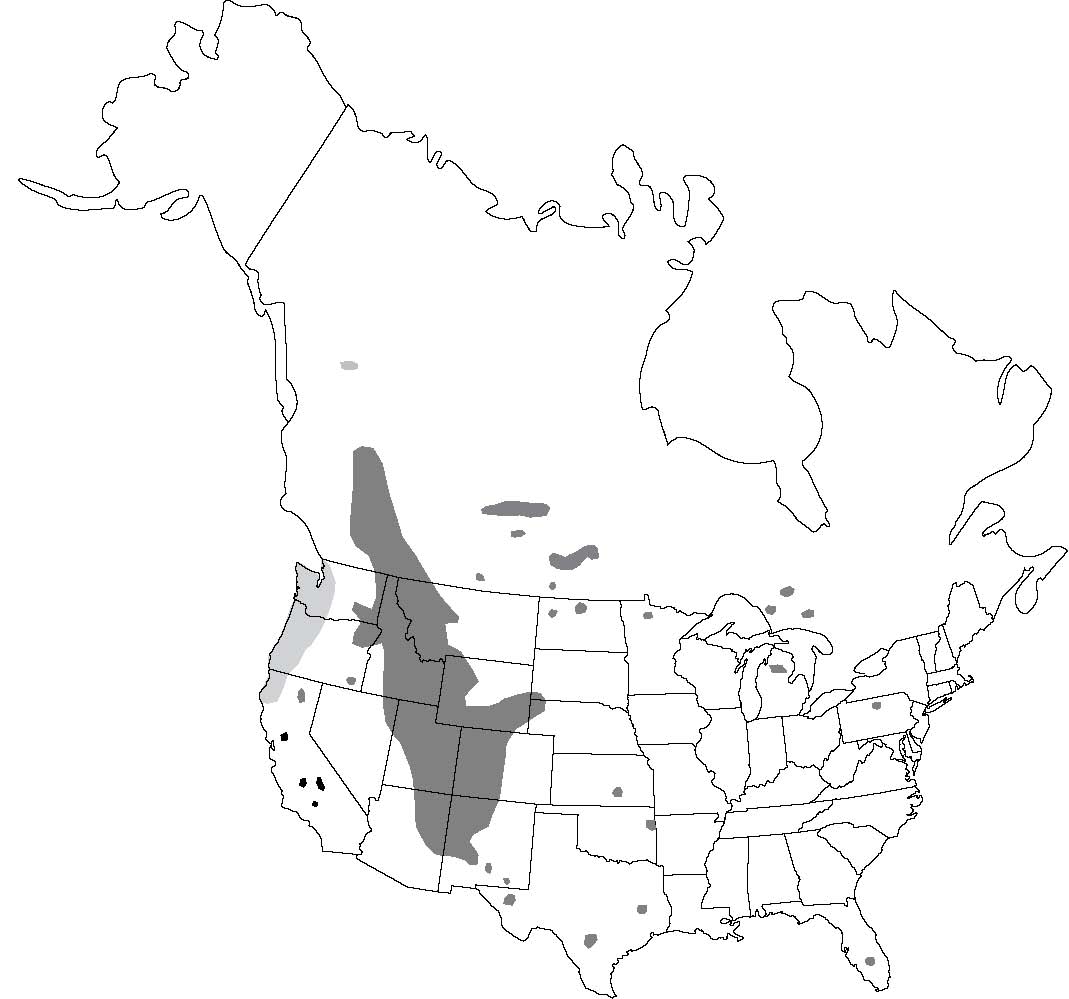
Fig. 2. Range of the Rocky
Mountain elk (horizontal stripes), Rocky Mountain
transplants (vertical stripes), Tule elk (dark)
Manitoban elk (medium), and Roosevelt elk (light).
The Rocky Mountain elk (Cervus
elaphus nelsoni) is found in the Rocky Mountain states
and in scattered locations in the Midwest and East (Fig.
2). The current distribution of the Roosevelt elk (C. e.
roosevelti) is the inland coastal areas of northern
California, Oregon, Washington, Vancouver Island,
British Columbia, and Afognak Island, Alaska. The Tule
elk (C. e. nannodes) is found only in California and the
Manitoban elk (C. e. manitobensis) is found in Manitoba
and Saskatchewan.
Habitat
Although elk once roamed
freely into lower elevation grasslands, they are now
found primarily close to heavily forested areas that are
dotted with natural or human-made (clear-cut) openings.
Typically, elk use the openings to forage for food. Elk
seek the shelter of dense stands of conifer and
deciduous trees for protection from temperature
extremes, predation, and harassment by humans. Elk
usually spend their summers at higher, cooler
elevations. In fall, they migrate along traditional
corridors (2 to 80 miles [3 to 133 km]) long to lower
elevations to escape weather extremes and snow depths
that prohibit foraging in winter. Some herds are not
migratory, spending the entire year within fairly
well-defined and restricted areas.
Food Habits
Elk graze on grasses and
forbs, and browse on shrubs, tree seedlings, and
saplings. Diet is variable, depending on the
availability and nutritive content of forages. Elk
dietary preferences often overlap those of domestic and
other wild ungulates. Where both grasses and shrubs are
available, elk may favor grasses. When snow reaches
sufficient depth to cover grasses and shrubs, elk are
forced to rely on conifer seedlings and saplings, and
bark and twigs of deciduous trees, such as aspen.
Wind-fallen branches and attached arboreal lichens are
an important energy source in winter.
General Biology, Reproduction, and Behavior
Weather and human
activities influence elk activity. Where no hunting is
allowed, elk readily habituate to humans and may be
observed foraging during daylight hours. Otherwise, elk
tend to forage primarily in the early morning hours, in
late afternoon, and during the night. They also forage
more on warmer south-facing slopes during daylight hours
in colder months, retiring to the thick protective cover
of conifer/deciduous forests in early afternoon. In
summer, elk forage early in the day when temperatures
are lower and seek refuge from midday heat and insects
in cooler riparian areas or forested, windswept ridge
tops.
Elk use a variety of
habitats and habitat components (slope, aspect) to
optimize feeding opportunities, thermal regulation, and
protection from predation. This flexibility is closely
associated with the impact elk have on domestic hay,
grain crops, and on pastures shared with domestic
livestock. For example, spring migration coincides with
the development of new growth of succulents, which
concentrates feeding in pastures and grain crops and
leads to heightened levels of damage.
The breeding season (rut)
begins in late summer, when dominant males (bulls) herd
“harems” of cows together for breeding. Cow elk may
breed as yearlings, but many breed first as 2-year-olds.
A single calf is born about 250 days following
conception.
Damage
Elk commonly impact
agricultural resources by competing with domestic
livestock for pasture and damaging cereal and hay crops,
ornamental plants, orchards, and livestock fences. Elk
also damage forest resources by feeding on seedlings and
saplings of coniferous and deciduous trees. During
winter, elk concentrate in areas where food is
available, including pastures, winter wheat fields, and
young conifer plantations. A survey conducted in 1989
indicated that elk caused damage to crops in seven
states, mostly to haystacks and pastures. Elk damage
appears to be a local problem that usually is dealt with
locally.
Elk damage problems are
increasing in property developed in traditional elk
wintering ranges. This problem can be avoided by zoning
regulations that prohibit development in such areas.
Because the elk is a
highly desired game animal, management efforts in the
last few decades have concentrated on increasing the
size of local elk herds. As elk numbers have gradually
increased in many parts of their range, the incidence
and intensity of damage to agriculture and forestry have
also increased.
Damage Identification
Plants browsed by elk have
a characteristic appearance. Vegetation is grasped
between the lower incisors and the upper palate and
ripped or torn, resulting in splintered and fragmented
plant parts (Fig. 3). In contrast, rabbits and large
rodents clip vegetation off at a sharp 45o angle (Fig.
4). Elk damage to conifer seedlings may appear as a
thorough stripping of bark from the upper half of the
growing tip or “lateral” (Fig. 5). This damage generally
occurs weeks after planting, usually in early to
midspring. Meadow mice gnaw or “girdle” rather than clip
as larger rodents and rabbits do, or browse as elk and
deer do. The appearance of damage to browsed plants is
similar for elk, deer, and cattle, but their tracks and
scats (droppings) are easily distinguished (Fig. 6).
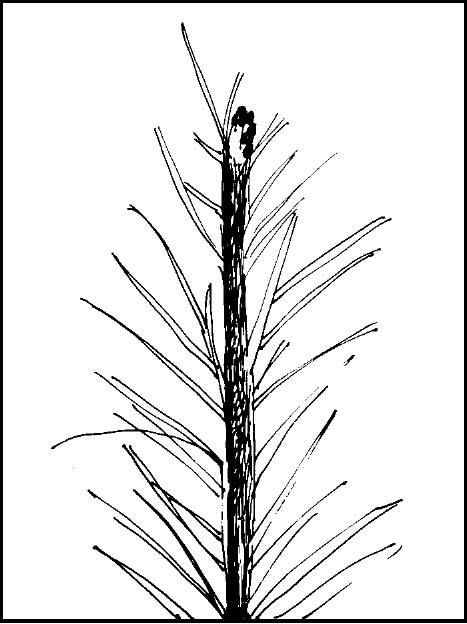
Fig. 3. Elk browsing results in a ragged twig edge.
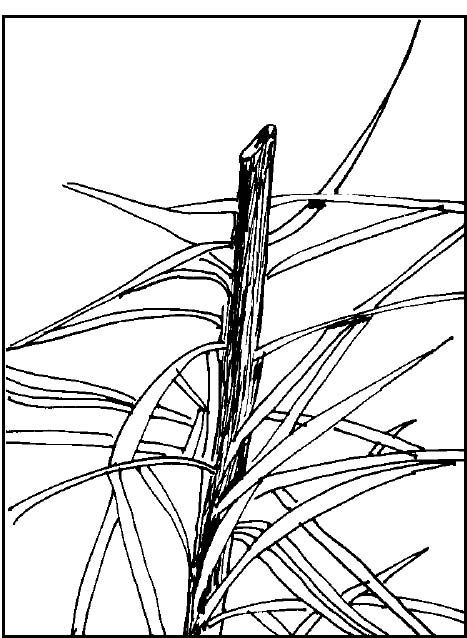
Fig. 4. Rabbit browsing results in twigs and small
branches cut cleanly at a 45° angle.

Fig. 5. Conifer seedling damaged by elk shortly after
planting.
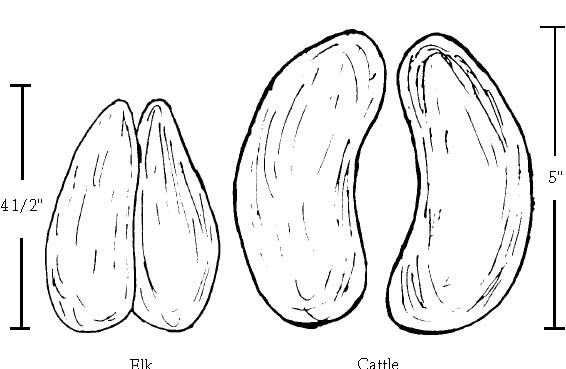
Fig. 6. Tracks of deer, elk, and cattle
Elk tend to roam over
greater expanses of habitat than deer, so the occurrence
of damage by elk is more widespread and sporadic than
damage by deer. Also, because elk move in groups instead
of singly, the nature of their destruction to crops and
pastures includes trampling, much like that of domestic
livestock.
Damage by elk is often
seasonal. Damage to hay and grain crops generally occurs
in spring when these crops are the first succulent
vegetation to emerge, and native forages are in short
supply. If native forages are chronically limited,
damage to crops may persist through harvest. Much of the
damage to orchards occurs in winter and late spring when
the growing tips of young (1- to 5-year-old) trees are
high in protein and highly digestible. Damage may
continue through late summer at a reduced level.
Conifers are often damaged after they are planted on
clear-cut sites. Elk are drawn to conifers when other
food supplies are limited and/or of low nutritive
quality. Elk also are attracted during spring when
conifers produce new growth that is especially palatable
and highly digestible. Damage to haystacks occurs during
winter when there is little food available for elk on
winter ranges. Elk damage to pastures usually occurs
during winter and during migration periods when elk move
between summer and winter ranges.
Elk usually damage areas
that border standing timber because they have learned
from their association with humans not to venture far
out into large openings. They also prefer riparian zones
and benches as opposed to steep slopes, and damage is
usually distributed accordingly. Much of the damage
caused by elk is in response to low availability of
forage on winter range; thus crops on winter range or
along migration routes are often damaged.
Legal Status
Elk are protected and
classified as a game animal in states and provinces
where they are sufficiently abundant. Elk are completely
protected in most areas with small populations.
Damage Prevention and Control Methods
In some situations, only
one technique for controlling elk damage is necessary.
In many situations, however, the greatest reduction and
prevention of future damage will be accomplished by
application of more than one damage control technique.
Exclusion
Fencing has provided
relief from elk damage where plants cannot be protected
individually, such as in hay and grain fields, large
orchards, and pastures. Six-foot-high (1.8-m) woven-wire
fences, topped with two strands of smooth or barbed wire
(Fig. 7) will prevent access, but the cost is high
(Table 1). Some states have cost-share programs wherein
some or all of the cost of fencing materials may be
borne by one or more agencies responsible for managing
elk damage.
Recently, high-voltage
(3,500- to 7,500-volt) electric fences have proven to be
a relatively inexpensive and effective alternative to
woven-wire fences. They feature 8 to 11 smooth strands
of triple-galvanized, high-tensile steel wire supported
by conventional fence post systems (Fig. 8).
Considerable expertise is required to construct these
fences, but when built properly, they can provide nearly
as much protection from damage as mesh fences.
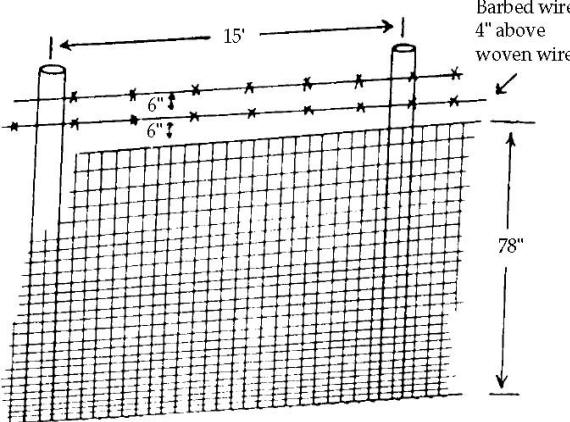
Fig. 7. Woven-wire fences
can exclude elk.

Fig. 8. A high-tensile electric fence can exclude elk.
Researchers in
Pennsylvania developed 4- to 5-strand electric fences
(Fig. 9) that provided 80% or more protection from deer
damage. In Oregon, an 8-foot (2.5-m) electric fence
consisting of 11 wires successfully kept elk from
entering a rhododendron nursery that previously had
sustained persistent trampling damage. A key component
of electric fences is the high-voltage charger or
“energizer.” These are available as 110 volt or
battery-operated units.
For a fence to be
effective, it must be seen by elk. In the case of an
electric fence, which a herd can easily run through, it
must be seen and associated with an electric shock.
Place branches along the top of livestock fences and
drape light-colored surveyor tape from electric fences
to make them more visible to elk. To help “initiate” elk
to the shocking power of fences, place peanut butter on
tinfoil strips and attach the strips to electric fence
wires 3 feet (1 m) above ground . For more details on
fencing, see the Deer chapter in this book.
Haystacks have
traditionally been protected by wooden panels (Fig. 10).
Because panels are expensive to build and unwieldy to
place in position, they are no longer recommended except
in cases where nothing else is available. With the
advent of the effective and less expensive electric
fencing, it is now feasible to place perimeter fences
around hay yards. They allow ranchers easier access to
hay and greater mobility in moving the hay within yards.
Electric fences such as those illustrated are permanent
installations, lacking the mobility of panel fencing, so
placement is a factor in choosing panels or electric
fences.
Haystacks can be protected
from elk for one or two seasons by wrapping plastic
barriers around them. Ten-foot-wide (3-m) sheets of
6-mil black plastic (Visqueen®) or netting made of
expanded polyethylene are commonly used. Attach the
sheets to standing stacks of hay bales by tying baling
twine around pebbles enclosed in a fold of plastic at
the top of the sheet, and tying the loose end of the
twine to baling twine on hay bales (Fig. 11). The
netting is simply stretched around hay stacks.

The Tensar® snow fence,
which comes in 8 x 100-foot (2.6 x 30-m) rolls and has a
30-year life span, can also be wrapped around haystacks.
State and federal wildlife agencies have been purchasing
it and loaning it to ranchers to use before winter elk
damage begins.
For smaller orchards
(fewer than 50 trees), protect individual trees with
6-foot (1.8-m) cylinders of welded wire (Fig. 12).
Protectors for individual
coniferous and deciduous tree seedlings are effective
until the leader (growing tip) or lateral branches grow
out of the protectors and are once again exposed to elk
browsing. Use rigid diamond-
Fig. 9. The Penn State
electric fence may be of use in excluding elk as well as
deer. pattern plastic or nylon tubes (Vexar®), netting,
and waterproof paper cylinders (bud caps) (Fig. 13) to
protect conifer seedlings. Vexar® tubes extend from
ground level to above the top of the seedling. Netting
and bud caps fit over the growing tips of the leader
stem and lateral branches. Vexar® tubes are more
expensive than netting and bud caps but have a longer
life span (about 5 years).

Tubex® tree shelters (Fig.
14) are translucent, solid-walled cylinders 5 to 6
Fig. 10. Wooden panels
have been used to protect haystacks. feet (1.5 to 1.8 m)
tall, and 5 to 6 inches
(12 to 15 cm) in diameter.
The cylinders create a mini-greenhouse that accelerates
the growth of seedlings. At $3.25 each, Tubex®
protectors are expensive. Vexar® protectors, netting,
and bud caps are recommended for conifer seedlings,
while Tubex® is recommended for deciduous tree
seedlings. Vexar® and Tubex® protectors must be held
upright by lashing them to stakes driven into the
ground. Both protectors are designed to biodegrade in
about 5 years. If support stakes are wooden, they must
be treated to prevent rot or they will break off at
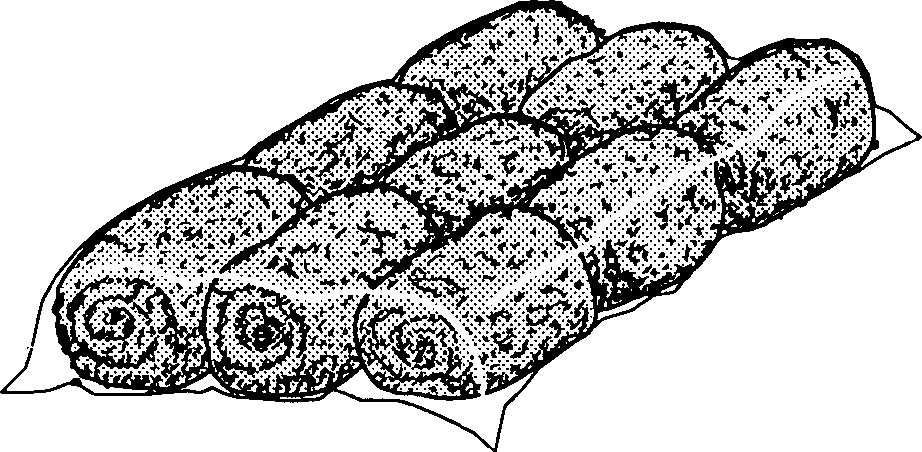
Elk can be excluded from tree regeneration sites by
dense slash left after
6' lings. Bud caps (right)
have also been used successfully.
 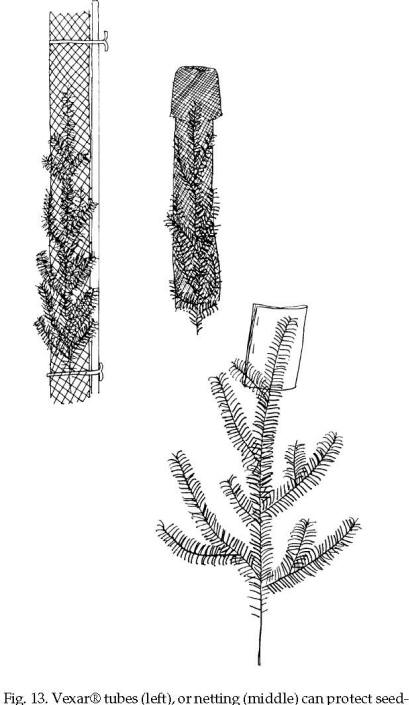
Unfortunately, when slash
is sufficiently thick to deny elk access to seedlings,
it provides protective cover for rodents. Subsequent
increases in rodent populations could result in severe
rodent damage to seedlings. Usually there is
insufficient slash to provide total coverage on sites.
Protection is provided to a limited number of seedlings
in places where the slash is sufficiently dense.
Cultural
Methods
Under limited
circumstances, elk may be “deferred” from damaging crops
by planting other forages that elk prefer. Broadcast
legumes and domestic annual and perennial grasses over
regeneration sites before planting conifer seedlings.
Grasses and legumes that are not sufficiently cropped by
elk, however, will provide excellent vole habitat, and
damage by these rodents to seedlings may become a
problem. Graze sheep in summer on such sites to remove
excess forage until elk begin to graze in fall and
winter.
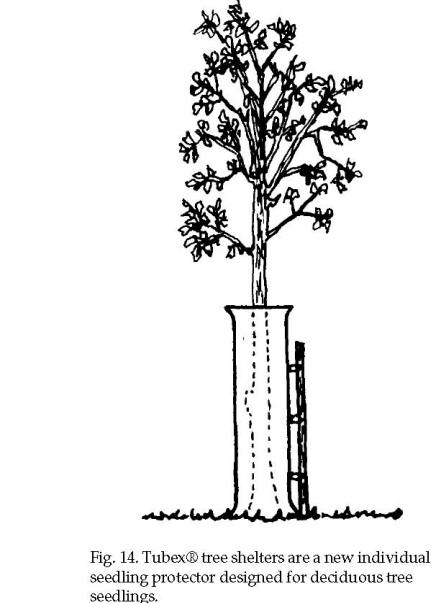
Food plots and salt blocks
have been used on public lands adjacent to agricultural
fields and pastures to reduce damage by resident and
migratory elk. Food plots are maintained in an early
successional state (grasses and forbs) by one or more
techniques: seeding, mowing, fertilizing, burning,
and/or spraying with herbicides. Effectiveness of this
approach is still undergoing evaluation. The expense of
establishing and maintaining substantial acreages of
high-quality food plots limits their use.
Planting taller seedlings
can reduce elk damage. Most seedlings are about 18
inches (46 cm) tall. Seedlings 36 inches (90 cm) or
taller will provide more browse than elk can crop, and
with their greater potential for rapid growth these
seedlings can grow out of the reach of elk faster.
The early release of
seedlings may also be achieved by eliminating other
vegetation. Studies in western Oregon demonstrated that
using herbicides to eliminate competing vegetation
allowed conifer seedlings to grow sufficiently fast that
they outgrew the browsing of deer and elk.
Elk, like deer, are
attracted to the edge habitat between openings and
forested areas. Their use of openings begins to decline
200 feet (60 m) into openings; by 400 to 600 feet (120
to 180 m), use drops below 50%. Creating larger openings
by clear-cutting larger acreages (100 to 200 acres [40
to 80 ha]) as opposed to the 40 to 50 acres (16 to 20
ha) currently practiced on public lands will decrease
elk damage in the interior portions of such clear-cuts.
Protecting seedlings on the perimeters of larger
clear-cuts with repellents or seedling protectors will
provide an integrated protection system.
Recent studies with deer
in the East suggest that concentrating projected timber
harvest into a shortened period of time will overwhelm
deer with a surplus of food, reducing the level of
damage to seedlings. Instead of spreading out projected
harvests over a 10-year period, all timber harvests are
conducted within 1 to 2 years and the area is not cut
again for 10 years. This system may work in other areas
where elk are causing significant damage to seedlings.
Placing the cuts in adjoining blocks (“progressive”
clear-cutting) rather than scattering them will also
reduce the amount of forest fragmentation, which is an
emerging concern in forest management.
Where elk and livestock
compete for the same forage, a long-term solution is a
system of successional cropping. If cattle placed on the
pasture from late spring through late summer do not
remove all the forage, it will recover, mature in early
fall, and provide quantities of high quality forage for
elk in winter. The elk, in turn, will crop and stimulate
the forage, providing good forage for cattle returning
to the pasture in spring. Such a system has increased
the availability of forage and numbers of both livestock
and elk. Careful planning is required to ensure that
proper numbers of livestock and elk use the pasture.
Special hunts may be required to ensure that excessive
numbers of elk do not occur.
Frightening
(Hazing)
Propane exploders (Fig.
15) can prevent elk from using sites for several weeks,
after which the elk lose interest and go elsewhere.
Generally, one exploder will protect 5 to 10 acres (2 to
4 ha). Several may be required for larger areas.
Exploders are most effective when their locations are
changed every few days so that elk do not habituate to
the sound pattern. Exploders may be an unacceptable
nuisance to nearby neighbors.
Elk may be temporarily
hazed or frightened out of crop fields, orchards, and
pastures by the use of fixed-wing aircraft or
helicopters, but both are expensive. Elk will return,
however, especially if pastures are on their traditional
winter range.
Repellents
Repellents may reduce elk
damage in orchards, vineyards, and conifer plantations.
Where frequent washing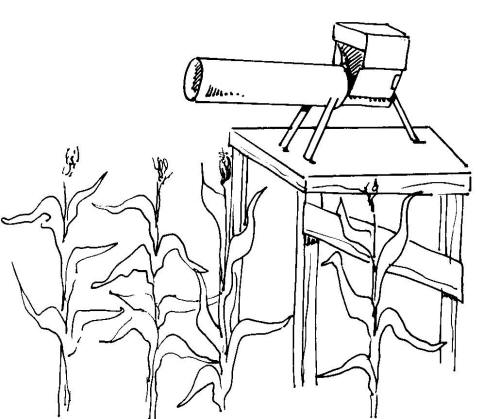 rains occur, some repellents must be applied more than
once. Damage can be prevented without treating the
entire area by applying odor repellents to plants within
a 25-foot-wide (10-m) strip around field edges where
most of the damage occurs.
rains occur, some repellents must be applied more than
once. Damage can be prevented without treating the
entire area by applying odor repellents to plants within
a 25-foot-wide (10-m) strip around field edges where
most of the damage occurs.
The US Forest Service has
a “20 to 80 percent” rule for determining whether
repellents will be successful: If elk damage to conifers
is less than 20%, application of the repellent will not
pay for itself. If the damage is over 80%, the elk have
become too habituated to feeding in the area and will
not be deterred by the application of repellents.
Little success is reported
with repellents such as human hair, tankage, blood meal,
or thiram. Successful repellents include formulations of
fermented eggs (Big Game Repellent® or Deer-Away®) and
hot sauce containing capsaicin. For additional
information on repellents, see the Pesticides and
Supplies and Materials sections in this book.
Population Reduction
Permits are issued
(usually for antlerless elk) to reduce local elk
populations to levels of damage that are acceptable.
These reductions generally are of two kinds: local herd
reduction, and problem-animal elimination. In the
former, the herd is usually too large for local
resources and a general reduction in population density
is required. Special elk damage hunts are established to
reduce the size of herds on public lands, and, in some
cases, on private property. Such hunts are conducted as
extra seasons for which hunters enter drawings. Hunters
must have good access to areas for these hunts to be
effective for herd reduction and/or problem-animal
elimination.
The second kind of
reduction is for individual landowners who experience
unacceptable losses of crops to one or a few elk.
Permits are issued to the individual landowner to
eliminate these problem animals; hunters usually are not
used to harvest the elk.
Elk-reduction hunts are
sensitive management issues. The general hunting public
has had difficulty understanding why there is a need to
remove individual elk, or to reduce populations when
only a limited number of licenses is available to hunt
for bulls. Effective public relations programs are
essential for acceptance of and support for population
reduction.
Special hunts may provide
temporary relief from damage, but the conditions
conducive to damage remain. Once the population
rebuilds, damage is likely to resume, especially in
orchards, crop fields, and pastures. Protection of
conifer seedlings by hunting to reduce local elk
densities is an exception. Seedlings can attain a height
sufficient to avoid elk damage within 3 to 5 years,
which is well within the period of protection afforded
by a series of successful special hunts.
Another form of population
reduction is the translocation of problem animals.
Capturing and translocating elk was a common procedure
in several states as long as there were areas
understocked with elk. Small numbers of elk (1 to 10)
were captured in large, baited corral traps.
Free-ranging individual elk were immobilized by drugs
injected by projectiles fired from rifles. These
programs are being phased out because states with
sufficient elk to cause damage problems no longer have
areas of too few elk. Costs of trapping and transporting
elk are prohibitive and are not recommended unless
outside financial assistance can be obtained.
A final potential
population reduction technique is the use of
reproductive inhibitors. Effective reproductive
inhibitors exist for elk. Unfortunately, there is no
effective, selective delivery system available to
implant or inject the inhibitors into the bodies of
free-ranging elk.
Compensation
Four states pay ranchers
directly for crop damage caused by elk. Funding for
claims (which have a low upper limit, usually under
$5,000) is taken from license fees and tags that hunters
pay to hunt elk and other game. Compensation may be
temporarily satisfactory to ranchers and farmers, but it
does nothing to alter the circumstances favoring damage,
so the damage will continue and may even increase.
Compensation should be considered as a temporary,
stop-gap response requiring a better, permanent
solution.
Compensation is not a
particularly efficient use of funds for reimbursing
individuals with damage. In Colo-rado’s $1.5 million
program, only $300,000 was spent in actual reimbursement
to persons with losses. Approximately $350,000 went to
administration expenses, and $800,000 to provide damage
prevention materials.
Economics of Damage and Control
Before any control program
is begun, determine whether the cost of control will
exceed the costs of damage. The costs of control methods
vary greatly (Table 1).
Cost-effectiveness of
damage control efforts may be approximated by dividing
the value of elk damage by the cost of control. The
result is usually referred to as the benefit-cost ratio.
If the ratio is less than 1.0, control is costing more
than damage and is not justifiable. More sophisticated
benefit-cost models that will allow projection of
benefits and costs into the future have yet to be
developed for elk.
Table 1. Costs of methods
for controlling elk damage.
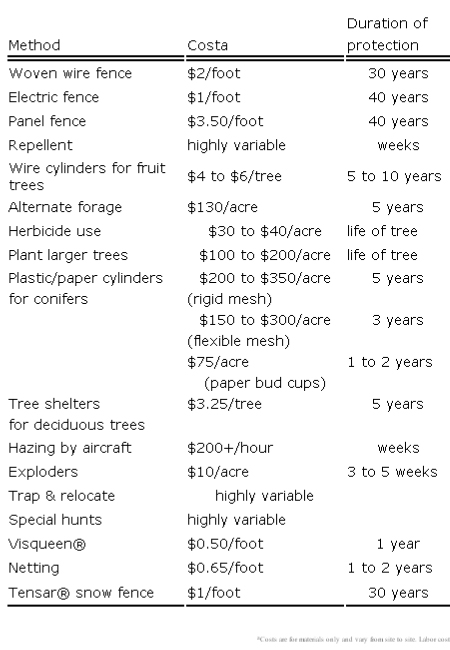
Acknowledgments
We thank the following
individuals for providing pertinent information: H. C.
Black, G. E. Burgoyne, J. E. Gillespie, M. Shaw, V. T.
Supplee, and D. E. Toweill.
Figure 1 from Schwartz and
Schwartz (1981).
Figure 2 adapted from
Thomas and Toweill (1982) by L. Bryant and C. Maser.
Figures 3, 4, and 7
through 15 by Jill Sack Johnson.
Figures 5 and 6 by the
authors.
For Additional Information
Andelt, W. F., D. L. Baker, and K. P. Burnham. 1991.
Relative preference of captive cow elk for
repellent-treated diets. J. Wildl. Manage. 56:164-173.
Anderson, E. W., and R. J.
Scherzinger. 1975. Improving quality of winter forage
for elk by cattle grazing. J. Range Manage. 28:120-125.
Byrne, A. E. 1989.
Experimental applications of high-tensile wire and other
fencing to control big game damage in northwest
Colorado. Proc. Great Plains Wildl. Damage Control
Workshop. 9:109-115.
Campbell, D. L., and J.
Evans. 1978. Establishing native forbs to reduce
black-tailed deer browsing damage to Douglas-fir. Proc.
Verteb. Pest Conf. 8:145-151.
Long, W. M. 1989. Habitat
manipulations to prevent elk damage to private
rangelands. Proc. Great Plains Wildl. Damage Control
Workshop. 9:101-103.
Peek, J. M. 1982. Elk.
Pages 851-861 in J. A. Chapman and G. A. Feldhamer, eds.
Wild mammals of North America: biology, management, and
economics. The Johns Hopkins Univ. Press. Baltimore,
Maryland.
Rochelle, J. A. 1992. Deer
and elk. Pages 333-350 in H. C. Black, ed. Silvicultural
approaches to animal damage management in Pacific
Northwest forests. US Dep. Agric. For. Serv. Tech. Rep.
PNW-GTR-287. Portland, Oregon.
Schneidmiller, J. F. 1988.
Fencing methods to control big game damage to stored
crops in Wyoming. Proc. Great Plains Wildl. Damage
Control Workshop. 8:217-221.
Thomas, J. W., and D.E.
Toweill, eds. 1982. Elk of North America: ecology and
management. Stackpole Books, Harrisburg, Pennsylvania.
698 pp.
United States Steel. 1980.
How to build fences with USS Max-10 200 high-tensile
fence wire. United States Steel, Pittsburgh,
Pennsylvania. 75 pp.
Witmer, G. W., and R.
Cogan. 1989. Elk and crop damage in Pennsylvania. Proc.
Eastern Wildl. Damage Control Conf. 4:220-224.
Editors
Scott E. Hygnstrom Robert
M. Timm Gary E. Larson
PREVENTION AND CONTROL OF
WILDLIFE DAMAGE — 1994
Cooperative Extension
Division Institute of Agriculture and Natural Resources
University of Nebraska -Lincoln
United States Department
of Agriculture Animal and Plant Health Inspection
Service Animal Damage Control
Great Plains Agricultural
Council Wildlife Committee
Special
thanks to:
Clemson University
|